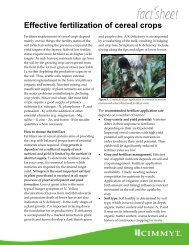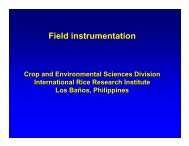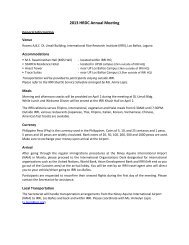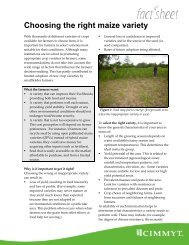Practical implementationSpecific <strong>in</strong>formation on m<strong>in</strong>imum tillage andconservation agriculture technologies for <strong>rice</strong> can beobta<strong>in</strong>ed from the <strong>Rice</strong>-Wheat Consortium (www.rwc.cgiar.org/<strong>in</strong>dex.asp).3.5 What option where?The relative “attractiveness” of the above technologiesfor farmers to respond to water scarcitydepends on the type and level of water scarcity(Chapter 1.7), on the irrigation <strong>in</strong>frastructure (orthe level of control that a farmer has over the irrigationwater), and on the socioeconomics of theirproduction environment.With absolute, or physical, water scarcity,farmers have little choice but to adapt to receiv<strong>in</strong>gless water than they would need to keep their fieldscont<strong>in</strong>uously flooded. Figure 3.6 presents a gradient<strong>in</strong> relative water availability and some appropriateresponse options. On the far right-hand side of the(horizontal) water axis, water is amply availableand farmers can practice cont<strong>in</strong>uous flood<strong>in</strong>g oflowland <strong>rice</strong> and obta<strong>in</strong> the highest yields. On thefar left-hand side, water is extremely short, suchas <strong>in</strong> ra<strong>in</strong>fed uplands, and yields are very low. Go<strong>in</strong>gfrom right to left along the water-availabilityaxis, water gets <strong>in</strong>creas<strong>in</strong>gly scarce and yields willdecl<strong>in</strong>e.Even with sufficient water available, goodland level<strong>in</strong>g, bund ma<strong>in</strong>tenance, construction offield channels, and thorough puddl<strong>in</strong>g (<strong>in</strong> the caseof puddled systems) will contribute to good cropgrowth and high yields. “Gett<strong>in</strong>g the basics right”is someth<strong>in</strong>g that all farmers can do, no matterwhether they operate <strong>in</strong> large- or small-scale irrigationsystems or whether they use their own sourcesof irrigation (such as tubewells) or shared sources.After crop establishment, cont<strong>in</strong>uous pond<strong>in</strong>g ofwater generally provides the best growth environmentfor <strong>rice</strong> and will result <strong>in</strong> the highest yields.After transplant<strong>in</strong>g, water levels should be around 3cm <strong>in</strong>itially, and gradually <strong>in</strong>crease to 5−10 cm with<strong>in</strong>creas<strong>in</strong>g plant height. With direct wet seed<strong>in</strong>g, thesoil should be kept just at saturation from sow<strong>in</strong>g tosome 10 days after emergence, and then the depthof ponded water should gradually <strong>in</strong>crease with<strong>in</strong>creas<strong>in</strong>g plant height. With direct dry seed<strong>in</strong>g,the soil should be moist but not saturated from sow<strong>in</strong>gtill emergence, or else the seeds may rot <strong>in</strong> thesoil. After sow<strong>in</strong>g, apply a flush irrigation if thereis no ra<strong>in</strong>fall to wet the soil. Saturate the soil whenplants have developed three leaves, and gradually<strong>in</strong>crease the depth of ponded water with <strong>in</strong>creas<strong>in</strong>gplant height. In special problem soils, <strong>in</strong>troduc<strong>in</strong>gsome form of alternate wett<strong>in</strong>g and dry<strong>in</strong>g (AWD)105Yield (t ha –1 )Traditionalupland <strong>rice</strong>systemFurrow, flush,spr<strong>in</strong>kler irrigationTechnologies to reduce water <strong>in</strong>putAerobic <strong>rice</strong>systemAWD SSCSoil <strong>management</strong>,reduced water depthLowland <strong>rice</strong>system∆Y = f (variety, <strong>management</strong>)0LowAerobic<strong>Water</strong> availabilityFCSoil conditionSFloodedHighFig. 3.6. Schematic presentation of yield responses to water availability and soil condition <strong>in</strong> different <strong>rice</strong> production systemsand their respective technologies to reduce water <strong>in</strong>puts. AWD = alternate wett<strong>in</strong>g and dry<strong>in</strong>g, SSC = saturated soil culture,FC = field capacity, S = saturation po<strong>in</strong>t, ΔY = change <strong>in</strong> yield. Adapted from Tuong et al (2005).29
or <strong>in</strong>creas<strong>in</strong>g the <strong>in</strong>ternal dra<strong>in</strong>age rate may improvecrop growth and yield (Ramasamy et al 1997). Theunderly<strong>in</strong>g reason may be improved soil aerationor the removal of toxic substances.The first response option to decreas<strong>in</strong>g wateravailability would be to check “the basics.” Theamount of water loss that can be reduced dependson the <strong>in</strong>itial condition of the <strong>rice</strong> field; if the basicsare right from the start, there is not much that canbe done any more. With progress<strong>in</strong>g water scarcity,establishment options alternative to transplant<strong>in</strong>gcan be considered if the turnaround time betweensoak<strong>in</strong>g and transplant<strong>in</strong>g is relatively large, suchas <strong>in</strong> some large-scale irrigation systems. If communityseedbeds or a commercial provider ofseedl<strong>in</strong>gs could be organized, this would be theleast water-consum<strong>in</strong>g method of gett<strong>in</strong>g a cropestablished. Seedl<strong>in</strong>gs could get transplanted a fewdays after land soak<strong>in</strong>g and puddl<strong>in</strong>g only, whilethe large-scale rais<strong>in</strong>g of seedl<strong>in</strong>gs would ensurean efficient use of water dur<strong>in</strong>g that period (ma<strong>in</strong>fields do not yet have to be soaked). Both direct wetand direct dry seed<strong>in</strong>g are alternative options. Dryseed<strong>in</strong>g will be effective only <strong>in</strong> relatively clayeyand impermeable soils that don’t need puddl<strong>in</strong>g toreduce the permeability any more.With further <strong>in</strong>creas<strong>in</strong>g water scarcity, water<strong>management</strong> practices dur<strong>in</strong>g the whole grow<strong>in</strong>gseason need to be considered. Instead of keep<strong>in</strong>g a5−10-cm depth of ponded water dur<strong>in</strong>g the grow<strong>in</strong>gseason, the depth can be reduced to around 3 cm.This will reduce the hydrostatic pressure and m<strong>in</strong>imizeseepage and percolation losses. In saturatedsoil culture (SSC), the depth of ponded water isreduced to 0−1 cm. Around flower<strong>in</strong>g, from 1 weekbefore to 1 week after the peak of flower<strong>in</strong>g, pondedwater should best be kept at 5-cm depth to avoid anypossible water stress that could result <strong>in</strong> severe yieldloss. The practice of SSC would require frequent(once <strong>in</strong> 2 days) applications of small amounts ofirrigation water, and hence require a high level ofcontrol over irrigation water. The practice of safeAWD can reduce water losses by a small to considerableamount without a yield penalty. To whatextent water losses can be reduced under SSC orAWD depends ma<strong>in</strong>ly on soil type and depth ofthe groundwater table: with a heavy clay soil andshallow groundwater (10−40 cm deep), water lossesare small to start with and reductions <strong>in</strong> water lossesare equally small. With more loamy or sandy soilsand/or deeper groundwater tables, reductions <strong>in</strong>water losses can be higher, but the risk of a reduction<strong>in</strong> yield also becomes higher. If water is gett<strong>in</strong>gso scarce that “safe AWD” is no longer possible,the periods between irrigation will have to becomelonger (lett<strong>in</strong>g the water <strong>in</strong> the field water tubes godeeper than 15 cm) and yield loss becomes <strong>in</strong>evitable.All forms of AWD require water control by thefarmer. With own water sources, such as tubewells,this is not a problem. In community-based or largescaleirrigation systems, a communal approach toAWD is required <strong>in</strong> which delivery of water togroups of farmers is scheduled to realize a certa<strong>in</strong>pattern of AWD. Irrigation system upgrad<strong>in</strong>g ormodernization may be required to do this, or smallstorage facilities (such as on-farm reservoirs) mayprovide the required water control (Chapter 5).With still further <strong>in</strong>creas<strong>in</strong>g water scarcity,yield of lowland <strong>rice</strong> under AWD will cont<strong>in</strong>ue togo down. At a certa<strong>in</strong> po<strong>in</strong>t, aerobic <strong>rice</strong> systemsbecome a viable alternative. How much less wateris used under aerobic conditions than under floodedconditions depends mostly on the seepage and percolation(SP) losses under flooded conditions and onthe deep percolation losses of irrigation water underaerobic conditions. Typical SP rates of flooded <strong>rice</strong>fields are given <strong>in</strong> Table 1.1 <strong>in</strong> Chapter 1.3. Underaerobic conditions, the amount of deep percolationdepends on the comb<strong>in</strong>ation of soil water-hold<strong>in</strong>gcapacity and method of irrigation, and is reflected<strong>in</strong> the irrigation application efficiency (EA). With aprecise dosage and tim<strong>in</strong>g of irrigation <strong>in</strong> relation tocrop transpiration and soil water-hold<strong>in</strong>g capacity,the EA <strong>in</strong> flash-flood irrigation can be up to 60%(Doorenbos and Pruit 1984). If furrow irrigation (orraised beds) is used, the EA can go up to 70%, andwith spr<strong>in</strong>kler irrigation up to 80% or more. Assum<strong>in</strong>gan average growth duration of 100 days, andmean ET values for <strong>rice</strong>, we can roughly calculatethe “break-even” po<strong>in</strong>t for SP rates <strong>in</strong> flooded fieldsthat would result <strong>in</strong> similar water requirements <strong>in</strong>aerobic fields with different irrigation methods(Table 3.8). When the SP rate <strong>in</strong> flooded <strong>rice</strong> is 3.5mm d −1 or higher, aerobic systems with flash-floodirrigation will require less water, and, if the SPrate is 0.5 mm d −1 or lower, only aerobic systemswith spr<strong>in</strong>kler irrigation require less water. Whenaerobic <strong>rice</strong> systems are direct (dry) seeded, as is thetypical target technology, an additional amount ofwater <strong>in</strong>put can be saved by forgo<strong>in</strong>g the wet landpreparation. An example of the cross-over po<strong>in</strong>t <strong>in</strong>terms of water availability where aerobic <strong>rice</strong> gives30
- Page 2: Water Management in Irrigated Rice:
- Page 5 and 6: PrefaceWorldwide, about 79 million
- Page 8 and 9: Fig. 1.2. Water balance of a lowlan
- Page 10 and 11: given in Table 1.1. Water losses by
- Page 14 and 15: Distribution (%)1009080706050403020
- Page 16 and 17: The plant-soil-water system22.1 Wat
- Page 18 and 19: Ψ Air-100 MPaDemandLeafXylemStemRo
- Page 20: tive to water deficit than cell enl
- Page 23 and 24: Water input (mm)4003503002502001501
- Page 25 and 26: Table 3.1b. Yield, water input, and
- Page 27: Grain yield (t ha -1 )98A2002 20037
- Page 30 and 31: Table 3.5. Water input (I = irrigat
- Page 32 and 33: Practical implementationTemperate e
- Page 36 and 37: Table 3.8. Comparison of water use
- Page 38: Flooded yield (t ha -1 )87A65432102
- Page 41 and 42: consumption (Hamilton 2003). Many t
- Page 44 and 45: Irrigation systems55.1 Water flows
- Page 46 and 47: the main system is supply-driven, f
- Page 48 and 49: Table 5.1. Area, water use, and tot
- Page 50 and 51: Appendix: InstrumentationDetailed d
- Page 52: 0.5 cm in diameter and spaced 2 cm
- Page 55 and 56: Bronson KF, Singh U, Neue HU, Abao
- Page 57 and 58: Lampayan RM, Bouman BAM, De Dios JL
- Page 59: Uphoff N. 2007. Agroecological alte


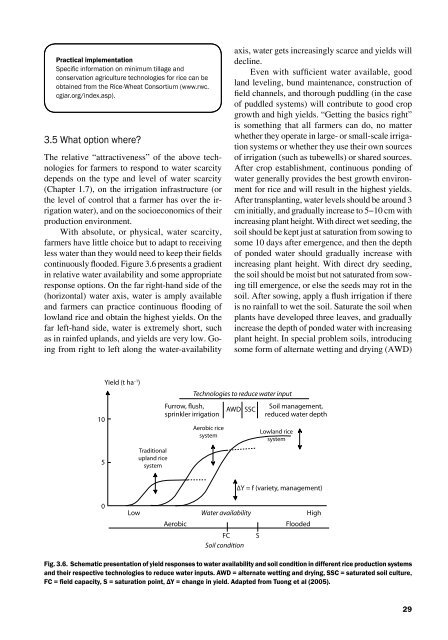


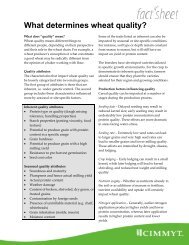

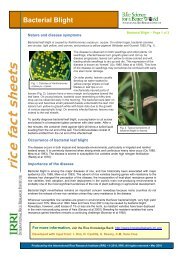

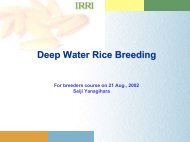
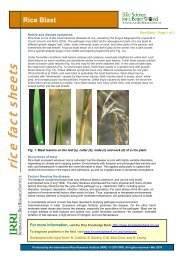
![International Standards' Organization â Rice Specification [ISO 7301]](https://img.yumpu.com/36696862/1/190x245/international-standards-organization-a-rice-specification-iso-7301.jpg?quality=85)

